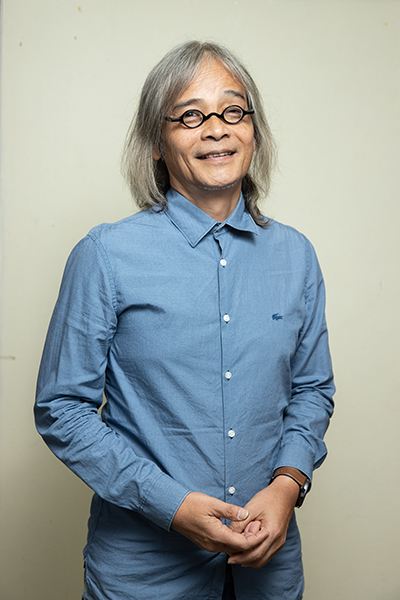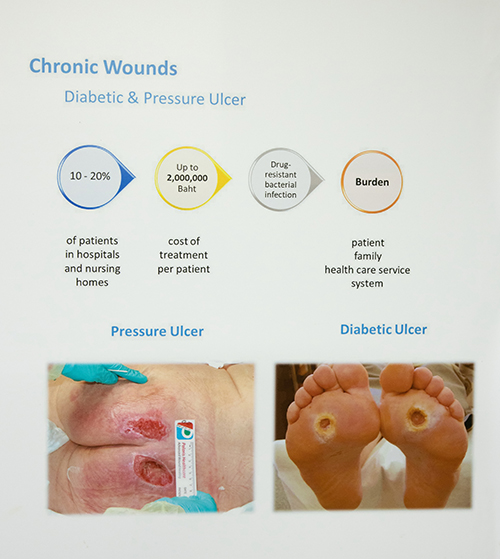“Following faith and patience, taking the first steps towards the future,” are the words framed above the exit in the Fast Neutron Research Facility Building, Department of Physics and Material Sciences, Chiang Mai University. These words are a testament to the amount of both faith and resilience required in the world of physics.
A compact pulse-modulation Cold Air Plasma Jet has been developed to treat and deactivate chronic bacteria wounds, cited as having “the power of lightning”. This plasma medicine technology can be applied to treat ulcers caused by diabetes as well as patients with bed sores in an effective, safe and cost-efficient way. This device has been developed as a result of research-based innovation where the university’s academics have applied their expertise to real tools.
The Cold Air Plasma Jet is the result of research done by the university’s Plasma and Beam Physics Facility, today recognized as one of the leading institutions in Thailand for research on the process of plasma application. The success of the Cold Air Plasma Jet in medical applications is one above and beyond any dream or expectation, helping to alleviate the pain and suffering of innumerable patients.
Cool Air Plasma Jet : “Nightingale”
The Yin and Yang of Plasma from Air
“It is universally accepted that one of the highlight properties of plasma is its ability to kill bacteria around a wound,” said Associate Professor Dr. Dheerawan Boonyawan, Department of Physics and Material Sciences, Faculty of Sciences, Chiang Mai University. He went on to explain that the development of the Cool Air Plasma Jet was the brainchild of one of the faculty’s doctorate students who thought outside the box, leading to the successful development of this product.
“We discovered that air which is low in humidity can be used to develop plasma,” continued Associate Professor Dr. Dheerawan. “I was fortunate enough to have worked with a doctorate student six years ago who had the idea to create plasma discharge from air. It is exceedingly difficult to achieve this outside of a phenomenon such as lightning. This student observed that while lightning when striking animals and humans causes harm, when it strikes a plant in a rice field, it flourishes. He went on to posit that the nitrogen fixation for rice plant growth can be harnessed and developed into a tool useful to the medical field. This was the foundation from which the Cold Air Plasma Jet was conceived. Typically, inert gas will be used for plasma discharge, but now we can get it directly from an air discharge. This was an excellent idea leading to the cool air plasma jet, a compact machine, with the power equivalent to that of lightning. At that time, we had students in nano technology, and through testing on bacteria and cells, we are now able to use the Cold Air Plasma Jet to treat a number of sores and wounds.”

Associate Professor Dr. Dheerawan Boonyawan, Department of Physics and Material Sciences,
Faculty of Sciences, Chiang Mai University
Associate Professor Dr. Dheerawan went on to explain that plasma discharge from air diffuses radially. With 78% nitrogen and 21% oxygen, the remaining air comprises other gases such as argon and carbon dioxide. Nitrogen helps stimulate cell growth and animal cell tissue while oxygen kills pathogens – the two gases acting as yin and yang, positive and negative, that together can kill bacteria in wounds and also helps stimulate healing.
Following this discovery and research, the research team at the Department of Physics and Material Sciences began working with the Faculty of Medicine, Chiang Mai University, conducting research into how to apply the technology to wounds, resulting in Plasma Medicine Technology and eventually the success story which is the Cool Air Plasma Jet model “Nightingale”. To that end, the startup Inno PlusCM was formed by the faculty to produce this product commercially.
Wound-Healing Plasma
The next challenge was to apply Cool Air Plasma Jet to real medical use. Plasma Medicine Technology was first applied for clinical trial to various hospitals across the Upper North of Thailand as well as some hospitals in Central Thailand such as Somdet Phra Sangharat Hospital, Supanburi Province. Tests were carried out on a number of ailments, from bed sores to fresh wounds, canker sores, infected wounds, drug-resistant sores, diabetic ulcers, to deep wounds.
The device itself is not challenging to use. Simply choose a setting of plasma does which will be visible on the screen. All settings are safe for wounds of all kinds. Once the device is in use radical transport from plasma head will be released with a light beam directing the airflow to the wound target. The process is over in just five short minutes.
Patient feedback has been positive, with patients reporting no pain at application of the jet and nurse reporting swift results as wounds heal. Only costing 1.8 baht per patient per month in electricity, this is also a cost-effective solution which can heal wounds without the expense of antibiotics or bandages.

Another benefit of the Cool Air Plasma Jet is that it reduces cost across the board. Instead of time-consuming wound care by medical personnel, patients can simply treat themselves at home, perhaps with a visit from a local public health provider.
Today, there are 1.3 million elderly Thais who are bed-bound. A further 600,000 Thais are diabetic. These numbers are on the rise as Thailand officially becomes an ageing society by 2025. Cool Air Plasma Jets : “Nightingale” will become an essential medical tool for the future.
Physics, from an outsiders’ perspective can be complex and intimidating to comprehend. But with faith and patience, with some innovation thrown in, physics can be applied to everyday life and be an integral part of society.